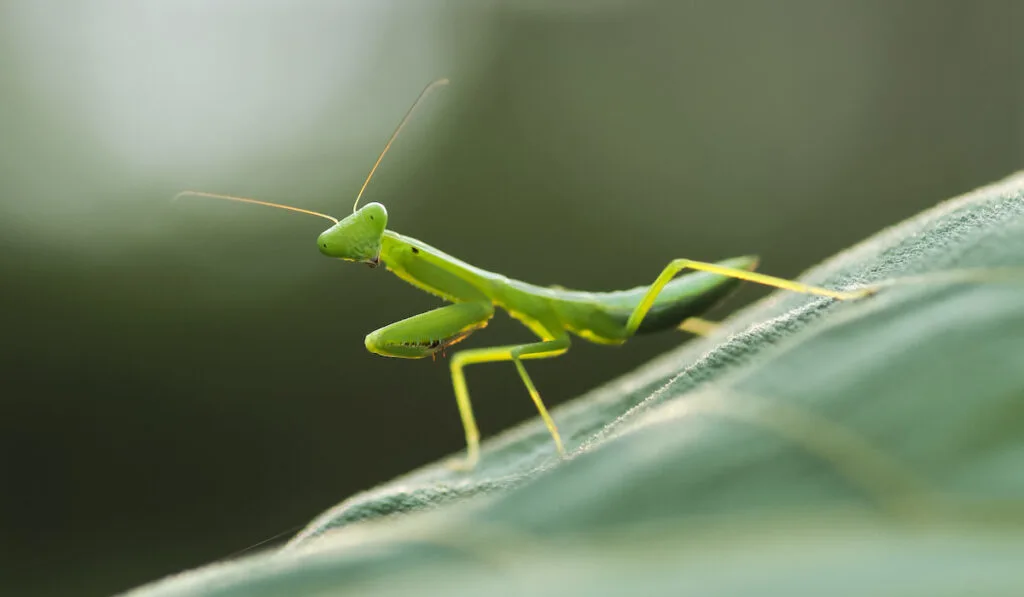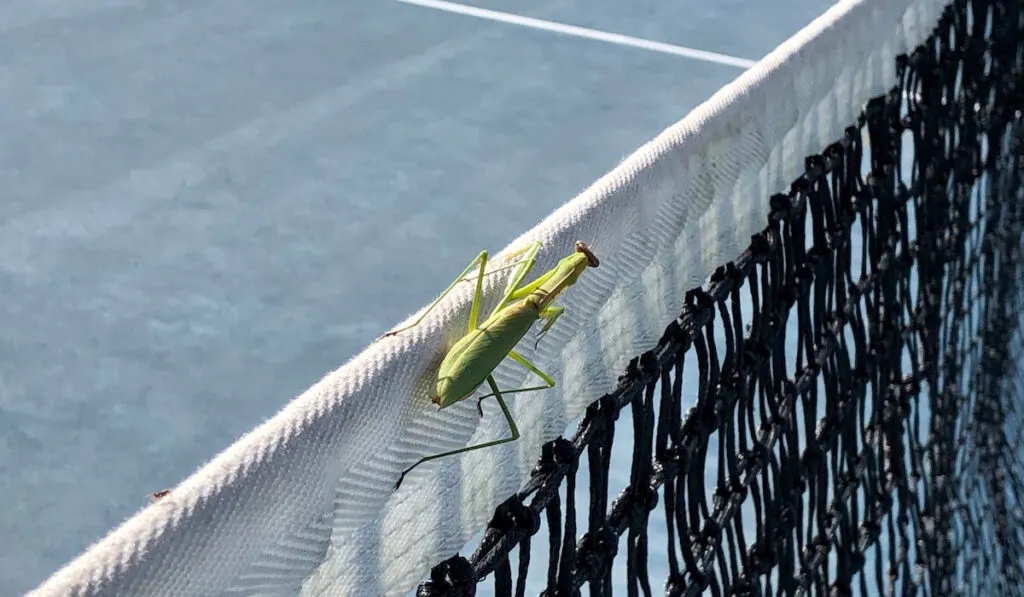Known to be a fierce hunter, the praying mantis is a picky carnivore that only preys on live prey not too large for it to handle.
Making it more interesting, the growth rate of the praying mantis all depends on how much and well it feeds. In cases of food scarcity, this ruthless hunter is known to opt for cannibalism, often eating their own kind.
Do praying mantises eat worms? Do they eat all worms or do they avoid some?
This article is here to give you all the details you need to know about worms as a feed for praying mantises.
Table of Contents
Do Praying Mantises Eat Worms?
Yes, praying mantises eat worms. Worms form a major part of the mantis’ diet.
The praying mantis is a patient hunter who captures and overcomes its prey and eats it alive. For this, worms are always an easy pick for them.
How Does a Praying Mantis Hunt?
A praying mantis will typically ambush its target prey with the sole aim of subduing it, then devouring it.
They are swift hunters with excellent sight, quick reflexes, and camouflage. They can turn their heads 180 degrees, and most significantly, they possess spine-covered raptorial legs which help them get a firm grip on their intended prey. With these attributes, the praying mantis is not just a hunter, but a very good one.
They use their skill of camouflaging with the environment and staying still, patiently waiting for the target prey to get close enough. Then within the blink of an eye, they attack and get it under a tight grasp using its claw-like forelimbs.
In rare cases, however, the praying mantis might be seen chasing after their target prey, but only when it’s necessary.
Depending on the size of the praying mantis, it will often take down anything it can subdue using its strong fore-limbs. When a small insect, animal, or worm crosses the path of a praying mantis, it is not a question of “if” it will be eaten. It is rather a question of “when!”

Types of Worms That Praying Mantises Eat
Silkworms and mealworms are favorites for praying mantises.
The larger praying mantises often go for larger worms whenever available. Earthworms, on the other hand, are not a common thing for the praying mantis. Besides, earthworms spend most of their time burrowed beneath the surface.
Waxworms and wax moths are also plump and juicy for your praying mantis. The pupae stage of most caterpillars, for a fact, change into fleshy moths that praying mantises love, and will often devour at first sight.
However, there are a few specific worms that are parasitic to the praying mantis, and these should be avoided by all means.
If at all they are infected by these parasites, the praying mantis will gradually lose the quality of its life, slowly sentencing it to death (details below on the worms harmful to praying mantis).
Are Worms Nutritious to Praying Mantises?
Although praying mantis love worms, worms should only be offered to them as treats. Just like any other treat, the animal might love it, but the treat is not necessarily nutritious.
Worms, in this case, are not full of the necessary nutrients a praying mantis needs, as compared to what a grasshopper, beetle, or locust would offer, so it is not sufficient for a praying mantis to be fed worms alone.
Therefore, although it is good to offer treats every once in a while, your focus should be on providing the praying mantis with the best diet possible.
On the other hand, not all worms are utterly unbeneficial to the praying mantis. Mealworms and silkworms are very nutritious to the praying mantis, and will immensely help the insect, especially during the earlier development stages as it grows.
Strictly speaking, though, silkworms and mealworms are not exactly worms, but rather, moth pupa and beetle larvae respectively. They are highly nutritious and if their feeding is not regulated, the praying mantis will undergo an immense increase in size that can be a problem keeping up with the feeding requirements it would need.

Are Some Worms Harmful to Praying Mantises?
As aforementioned, some types of parasitic worms depend on the praying mantis as a host. If a mantis is unfortunate enough to be infected by one, it is generally a death sentence for the praying mantis.
Horsehair worms, also known as Gordian worms, for example, are entirely fatal for the praying mantis. Available in over 350 types, horsehair worms are distinguished by their twisted, thread-like bodies that look similar to horsehair strands. They get introduced to the mantis’ body through the feeds that the mantis eats, and once inside the abdomen, they continually grow, at times reaching over 35 inches!
Over time, the horsehair worm will outgrow the size of the mantis’ abdomen, and will soon take over the nervous system, the motor functions, and even the mind, soon leading the mantis into water bodies where the mantis will drown, letting the worm burst out to find another host.
Lucky enough, the praying mantis is intelligent enough to stay away from anything it believes to be infested, especially anything dead.

Do Praying Mantises Prefer Eating Worms?
While they can be picky eaters, the praying mantis does not hold any preference for what they eat. They will devour anything available.
The praying mantis will not usually go for the typical garden worms like earthworms, but rather have an eye for mealworms and silkworms.
As aforementioned, mealworms and silkworms are not worms, but take up their names because of the similar look they have. Therefore, the praying mantis is not really into worms, but more, insects, like grasshoppers, locusts, bees, flies, caterpillars, crickets, and mosquitoes.
Should You Feed Worms to Praying Mantises in Captivity
Yes, some, like mealworms, are a good source of nutrition to a praying mantis. However, you should be careful not to feed wild captured worms to the praying mantis, as these could be polluted with chemicals that are toxic to the gut of the mantis, or may harbor parasites.
As much as possible, try to replicate the diet of the praying mantis in the wild while feeding one in captivity.
In the wild, a praying mantis will be cautious of the hazards presented by nature, and will only eat when it is necessary. In captivity, however, a mantis will never be concerned about the potential dangers of free-style eating, and will naturally devour anything presented before it.

How to Keep a Praying Mantis Safe in Your Garden
The praying mantis is an excellent predator and often works best when used as pest control. Keeping them in your garden, however, might be a hard task because they do not possess any form of defense mechanism against larger predators.
A female praying mantis, for example, will lay an ootheca, an egg sack, which often holds 200 or more eggs, with a protective cover attached beneath leaves, branches, or even on walls. The cover might be sufficient enough to shield the eggs from cold, but will never be enough to protect the sack from insects like ants.
Therefore, finding a good spot to let the eggs mature till they hatch should be a priority, just in case you come across a sack.
Are Praying Mantises Cannibals?
Under rare circumstances of extreme hunger, praying mantis will opt for cannibalism.
Of course, this won’t be something easy, as each mantis often gives the fight of their lives to escape being eaten by the other, and a full-blown battle will go down with each one trying to pin down the other with their strong fore-limbs.
In the end, the stronger eats the weaker one.
Can Worms and Praying Mantises Live Together?
No! Nothing is safe around a praying mantis, not even its own kind. The praying mantis is a fierce hunter who will attack the worm whenever a chance presents itself.
Since they only go for what they can comfortably pin down and overpower, worms might just share some space with smaller mantises, but the harmony won’t last long.

Praying Mantis as Pest Control
Employment of the praying mantis as pest control is a brilliant idea to get rid of some of the peskiest and most difficult pests that attack your gardens, such as aphids and worms.
However, the downside to their existence in the garden is that they can never tell the difference between helpful insects and pests, but rather go for anything moving that is small enough for them to eat.
Conclusion
Praying mantis likes worms. However, worms are not as nutritious to the mantis as other foods could be.
So before considering offering any kind of worm to your pet mantis, you should first consider offering feeds that are nutritious to the mantis.
Silkworms (which aren’t actually worms at all) are highly nutritious for a mantis.
Resources
- https://wormmy.com/do-praying-mantis-eat-worms/
- https://askinglot.com/do-praying-mantis-eat-worms
- https://www.rovepestcontrol.com/what-does-a-praying-mantis-eat
- https://schoolofbugs.com/do-praying-mantis-eat-worms/
- https://www.prayingmantisshop.com/info-mantis.html
- https://usmantis.com/blogs/news/what-do-you-feed-your-mantis-how-often-how-much
- https://www.keepingexoticpets.com/do-praying-mantis-eat-mealworms/
